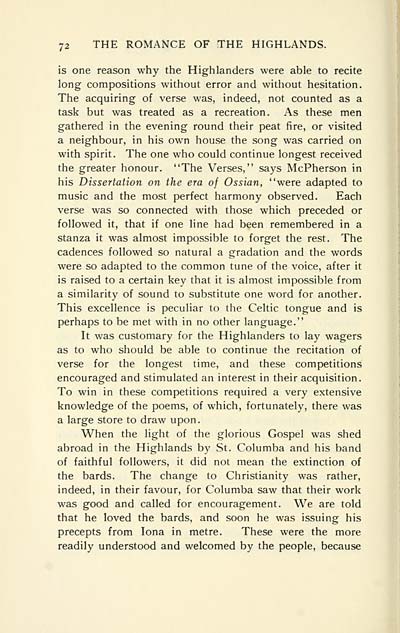Download files
Complete book:
Individual page:
Thumbnail gallery: Grid view | List view

72 THE ROMANCE OF THE HIGHLANDS.
is one reason why the Highlanders were able to recite
long compositions without error and without hesitation.
The acquiring of verse was, indeed, not counted as a
task but was treated as a recreation. As these men
gathered in the evening round their peat fire, or visited
a neighbour, in his own house the song was carried on
with spirit. The one who could continue longest received
the greater honour. "The Verses," says McPherson in
his Dissertation on the era of Ossian, "were adapted to
music and the most perfect harmony observed. Each
verse was so connected with those which preceded or
followed it, that if one line had been remembered in a
stanza it was almost impossible to forget the rest. The
cadences followed so natural a gradation and the words
were so adapted to the common tune of the voice, after it
is raised to a certain key that it is almost impossible from
a similarity of sound to substitute one word for another.
This excellence is peculiar to the Celtic tongue and is
perhaps to be met with in no other language."
It was customary for the Highlanders to lay wagers
as to who should be able to continue the recitation of
verse for the longest time, and these comp>etitions
encouraged and stimulated an interest in their acquisition.
To win in these competitions required a very extensive
knowledge of the poems, of which, fortunately, there was
a large store to draw upon.
When the light of the glorious Gospel was shed
abroad in the Highlands by St. Columba and his band
of faithful followers, it did not mean the extinction of
the bards. The change to Christianity was rather,
indeed, in their favour, for Columba saw that their work
was good and called for encouragement. We are told
that he loved the bards, and soon he was issuing his
precepts from lona in metre. These were the more
readily understood and welcomed by the people, because
1
is one reason why the Highlanders were able to recite
long compositions without error and without hesitation.
The acquiring of verse was, indeed, not counted as a
task but was treated as a recreation. As these men
gathered in the evening round their peat fire, or visited
a neighbour, in his own house the song was carried on
with spirit. The one who could continue longest received
the greater honour. "The Verses," says McPherson in
his Dissertation on the era of Ossian, "were adapted to
music and the most perfect harmony observed. Each
verse was so connected with those which preceded or
followed it, that if one line had been remembered in a
stanza it was almost impossible to forget the rest. The
cadences followed so natural a gradation and the words
were so adapted to the common tune of the voice, after it
is raised to a certain key that it is almost impossible from
a similarity of sound to substitute one word for another.
This excellence is peculiar to the Celtic tongue and is
perhaps to be met with in no other language."
It was customary for the Highlanders to lay wagers
as to who should be able to continue the recitation of
verse for the longest time, and these comp>etitions
encouraged and stimulated an interest in their acquisition.
To win in these competitions required a very extensive
knowledge of the poems, of which, fortunately, there was
a large store to draw upon.
When the light of the glorious Gospel was shed
abroad in the Highlands by St. Columba and his band
of faithful followers, it did not mean the extinction of
the bards. The change to Christianity was rather,
indeed, in their favour, for Columba saw that their work
was good and called for encouragement. We are told
that he loved the bards, and soon he was issuing his
precepts from lona in metre. These were the more
readily understood and welcomed by the people, because
1
Set display mode to: Large image | Transcription
Images and transcriptions on this page, including medium image downloads, may be used under the Creative Commons Attribution 4.0 International Licence unless otherwise stated. ![]()
| Early Gaelic Book Collections > Ossian Collection > Romance of the Highlands > (102) |
|---|
| Permanent URL | https://digital.nls.uk/81816849 |
|---|
| Description | Selected books from the Ossian Collection of 327 volumes, originally assembled by J. Norman Methven of Perth. Different editions and translations of James MacPherson's epic poem 'Ossian', some with a map of the 'Kingdom of Connor'. Also secondary material relating to Ossianic poetry and the Ossian controversy. |
|---|
| Description | Selected items from five 'Special and Named Printed Collections'. Includes books in Gaelic and other Celtic languages, works about the Gaels, their languages, literature, culture and history. |
|---|

